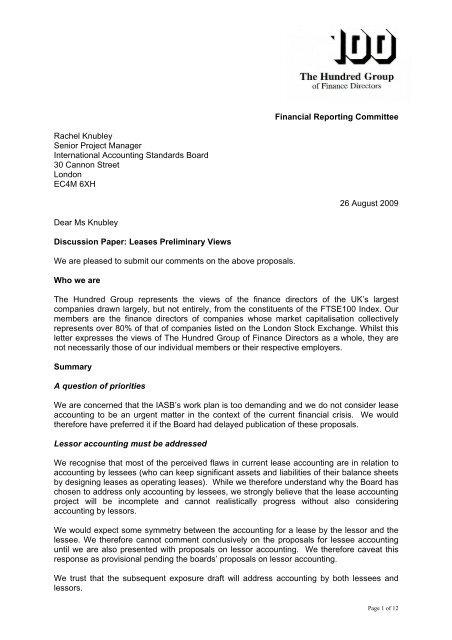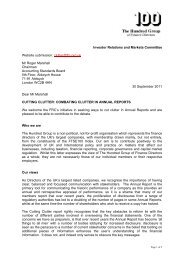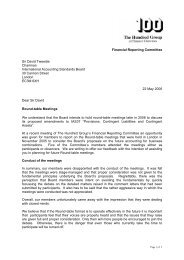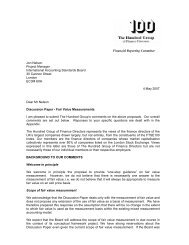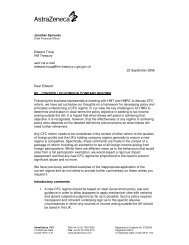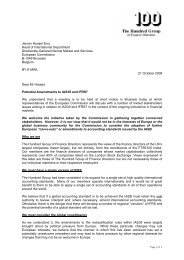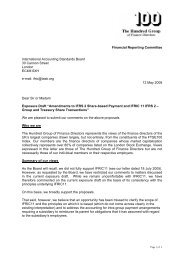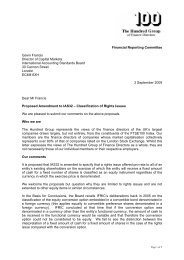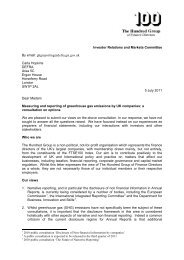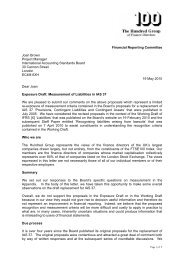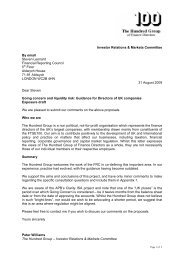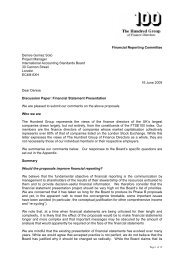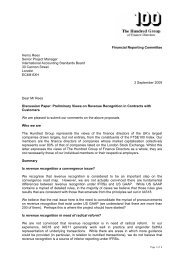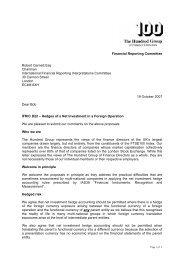Financial Reporting Committee Rachel Knubley Senior Project ...
Financial Reporting Committee Rachel Knubley Senior Project ...
Financial Reporting Committee Rachel Knubley Senior Project ...
You also want an ePaper? Increase the reach of your titles
YUMPU automatically turns print PDFs into web optimized ePapers that Google loves.
<strong>Rachel</strong> <strong>Knubley</strong><br />
<strong>Senior</strong> <strong>Project</strong> Manager<br />
International Accounting Standards Board<br />
30 Cannon Street<br />
London<br />
EC4M 6XH<br />
Dear Ms <strong>Knubley</strong><br />
Discussion Paper: Leases Preliminary Views<br />
We are pleased to submit our comments on the above proposals.<br />
Who we are<br />
<strong>Financial</strong> <strong>Reporting</strong> <strong>Committee</strong><br />
26 August 2009<br />
The Hundred Group represents the views of the finance directors of the UK’s largest<br />
companies drawn largely, but not entirely, from the constituents of the FTSE100 Index. Our<br />
members are the finance directors of companies whose market capitalisation collectively<br />
represents over 80% of that of companies listed on the London Stock Exchange. Whilst this<br />
letter expresses the views of The Hundred Group of Finance Directors as a whole, they are<br />
not necessarily those of our individual members or their respective employers.<br />
Summary<br />
A question of priorities<br />
We are concerned that the IASB’s work plan is too demanding and we do not consider lease<br />
accounting to be an urgent matter in the context of the current financial crisis. We would<br />
therefore have preferred it if the Board had delayed publication of these proposals.<br />
Lessor accounting must be addressed<br />
We recognise that most of the perceived flaws in current lease accounting are in relation to<br />
accounting by lessees (who can keep significant assets and liabilities of their balance sheets<br />
by designing leases as operating leases). While we therefore understand why the Board has<br />
chosen to address only accounting by lessees, we strongly believe that the lease accounting<br />
project will be incomplete and cannot realistically progress without also considering<br />
accounting by lessors.<br />
We would expect some symmetry between the accounting for a lease by the lessor and the<br />
lessee. We therefore cannot comment conclusively on the proposals for lessee accounting<br />
until we are also presented with proposals on lessor accounting. We therefore caveat this<br />
response as provisional pending the boards’ proposals on lessor accounting.<br />
We trust that the subsequent exposure draft will address accounting by both lessees and<br />
lessors.<br />
Page 1 of 12
We broadly support the proposals<br />
While there are some aspects of the proposals with which we disagree, we broadly support<br />
them. Indeed, we believe that the proposals have been well thought through and are well<br />
presented.<br />
We accept the boards’ analysis of the assets and liabilities arising under simple leases. We<br />
support the right-of-use model and agree with the boards’ decision to not to require a<br />
components approach to accounting for leases (though we appreciate that this causes the<br />
recognition of obligations in relation to lease options that would not otherwise meet the<br />
definition of a liability in the existing Conceptual Framework).<br />
Present value of obligation to pay rentals<br />
Discount rate<br />
We would prefer that the lessee’s incremental borrowing rate is used only if it is not<br />
practicable to estimate the rate implicit in the lease (as is the case under the existing<br />
standards). We believe that the estimate of the rate implicit in the lease provide the best<br />
estimate of the finance costs associated with the lease. Use of the rate implicit in the lease<br />
will therefore also give the best estimate of the right of use asset associated with the lease.<br />
Contingent rentals<br />
We do not support the probability-weighted estimate (or expected value) approach to<br />
measuring future contingent rentals. We are concerned that users will wrongly believe that<br />
the outcome is more accurate that that resulting from a less complex approach.<br />
We support the most likely rental payment approach because it will be workable in practice<br />
and will result in an obligation to pay rentals that will reflect a possible outcome. Moreover,<br />
we believe that this approach is consistent with guidance on making a ‘best estimate’ of an<br />
obligation provided in IAS37, which specifies the use of the expected value approach where<br />
the provision being measured involves a large population of items but where a single<br />
obligation is being measured states that “the most likely outcome may be the best estimate<br />
of the liability”.<br />
Changes in the obligation to pay rentals<br />
Consistent with the right-of-use principle underlying the proposed accounting model, we<br />
believe that a change in the obligation to pay rentals should be recognised as an adjustment<br />
of the right-of-use asset if it reflects a change in the right to use the asset. Otherwise it<br />
should be recognised in profit or loss.<br />
Accordingly, we believe that a change in the obligation to pay rentals resulting from a change<br />
in the expected lease term should be recognised as an adjustment to the right of use asset<br />
and a change resulting from a change in the estimate of future contingent rentals should be<br />
recognised in profit or loss (shown separately from the depreciation or amortisation of rightof-use<br />
assets).<br />
Embedded derivatives<br />
As a consequence of the boards’ decision not to require a components approach to<br />
accounting for leases, the effect of embedded derivatives in relation to contingent rentals and<br />
residual values will be taken into account in estimating the obligation to pay lease rentals.<br />
We therefore believe that it serves no purpose to separately account for those embedded<br />
derivatives that are not considered to be ‘closely related’ to the host lease contract. In the<br />
Page 2 of 12
interests of removing unnecessary complexity, we therefore believe that derivatives<br />
embedded within lease contracts should be excluded from the scope of IAS39.<br />
Short-term leases<br />
We agree with the boards that it may be difficult to define a short-term lease and that there is<br />
a risk that leases may be structured in order to take advantage of simplified accounting for<br />
short-term leases.<br />
However, the boards should recognise that if they do not take a pragmatic approach with<br />
regard to short-term leases we would end up in the situation where the hire of equipment<br />
such as vehicles, cranes and skips for a period of a few weeks or even days would be<br />
recognised as a right-to-use asset and fully depreciated within the same accounting period<br />
(thereby “grossing up” the movements on tangible and intangible assets and potentially<br />
distorting important capital replacement measures).<br />
As the effect of discounting would be immaterial in such cases, the accounting result would<br />
be the same as if the lease rentals were simply expensed, i.e. treated as if they were<br />
operating leases.<br />
Please feel free to contact me if you wish to discuss our comments on the proposals.<br />
Yours sincerely<br />
Chris Lucas<br />
Chairman<br />
The Hundred Group - <strong>Financial</strong> <strong>Reporting</strong> <strong>Committee</strong><br />
Page 3 of 12
CHAPTER 2: SCOPE OF THE LEASE ACCOUNTING STANDARD<br />
Question 1<br />
APPENDIX<br />
The boards tentatively decided to base the scope of the proposed new lease<br />
accounting standard on the scope of the existing lease accounting standards. Do you<br />
agree with this proposed approach?<br />
If you disagree with the proposed approach, please describe how you would define<br />
the scope of the proposed new standard.<br />
Both IAS17 and FAS13 define a lease as an agreement where the lessor conveys to the<br />
lessee a right to use an asset for an agreed period of time. The boards propose a new<br />
accounting model for leases which is based on the recognition as an asset of the right to use<br />
a leased item. We therefore believe that it would be appropriate to base the scope of the<br />
proposed new standard on the existing standards. However, we support principles-based<br />
accounting standards and we therefore believe that the boards should justify any exemptions<br />
from the scope of the proposed standard (such justification is lacking with regard to the<br />
scope exemptions in the existing standards).<br />
Question 2<br />
Should the proposed new standard exclude non-core asset leases or short-term<br />
leases? Please explain why.<br />
Please provide how you would define those leases to be excluded from the scope of<br />
the proposed new standard.<br />
From our reading of paragraphs 2.16 and 2.18 of the Discussion Paper, we understand that<br />
some constituents argue for simplified accounting for leases of non-core assets and shortterm<br />
leases (not their exclusion from the scope of the standard), because the costs<br />
associated with recognising and measuring the assets and liabilities arising from such leases<br />
outweighs the benefits.<br />
We concur with the boards that defining non-core assets may be difficult and that there may<br />
be material assets and liabilities associated with leases of non-core assets. We therefore do<br />
not believe that there are grounds for simplified accounting for leases solely because they<br />
are in relation to non-core assets.<br />
We also agree that it may be difficult to define a short-term lease and that there is a risk that<br />
leases may be structured in order to take advantage of simplified accounting for short-term<br />
leases. However, the boards should recognise that if they do not take a pragmatic approach<br />
with regard to short-term leases we would end up in the situation where the hire of<br />
equipment such as vehicles, cranes and skips for a period of a few weeks or even days<br />
would be recognised as a right to use asset and fully depreciated within the same accounting<br />
period (thereby “grossing up” the movements on tangible and intangible assets and<br />
potentially distorting important capital replacement measures).<br />
As the effect of discounting would be immaterial in such cases, the accounting result would<br />
be the same as if the lease rentals were simply expensed, i.e. treated as if they were<br />
operating leases.<br />
Page 4 of 12
CHAPTER 3: APPROACH TO LESSEE ACCOUNTING<br />
Question 3<br />
Do you agree with the boards’ analysis of the rights and obligations, and assets and<br />
liabilities arising in a simple lease contract? If you disagree, please explain why.<br />
We have commented many times before that the boards should have focussed their efforts<br />
on the review of their respective conceptual frameworks before embarking on the review of<br />
individual accounting standards. As things stand, the boards have yet to publish their<br />
preliminary views on the definition of an asset and a liability and we must therefore consider<br />
the new lease accounting model in the context of the existing definitions. In that context, we<br />
agree that the right to use a leased item meets the definition of an asset and the related<br />
obligation to pay rentals meets the definition of a liability. While the proposed accounting for<br />
more complex leases does not always satisfy the definition of an asset or liability this is an<br />
acceptable result of the boards’ decision not to require a components approach to<br />
accounting for leases (we return to this in our answer to Question 13).<br />
Question 4<br />
The boards tentatively decided to adopt an approach to lessee accounting that would<br />
require the lessee to recognise:<br />
(a) An asset representing the right to use the leased item for the lease term (the<br />
right-of-use asset).<br />
(b) A liability for its obligation to pay rentals.<br />
Appendix C describes some possible accounting approaches that were rejected by the<br />
boards. Do you support the proposed approach?<br />
If you support an alternative approach, please describe the approach and explain why<br />
you support it.<br />
We support the proposed approach.<br />
We recognise the flaws of the existing accounting model as set out in paragraphs 1.12. to<br />
1.14 of the Discussion Paper and that it fails to represent faithfully the economics of many<br />
lease contracts that are accounted for as operating leases.<br />
We do not believe that the ‘whole asset approach’ is consistent with the definition of an asset<br />
and a liability and that it has the effect of overstating an entity’s assets and liabilities. We are<br />
aware that the whole asset approach has some support among investors but we do not<br />
believe that it faithfully represents the economic substance of lease arrangements.<br />
Question 5<br />
The boards tentatively decided not to adopt a components approach to lease<br />
contracts. Instead, the boards tentatively decided to adopt an approach whereby the<br />
lessee recognises:<br />
(a) A single right-of-use asset that includes rights acquired under options.<br />
Page 5 of 12
(b) A single obligation to pay rentals that includes obligations arising under<br />
contingent rental arrangements and residual value guarantees.<br />
Do you support the proposed approach? If not, why?<br />
We support the boards’ approach.<br />
Components of complex leases are interrelated and usually act together to provide the lessor<br />
with an acceptable overall return. We therefore believe that to account separately for those<br />
components would not faithfully represent the commercial substance of the lease.<br />
Under the boards’ proposed approach the effect of embedded derivatives in relation to<br />
contingent rentals and residual values will be taken into account in estimating the obligation<br />
to pay lease rentals. We therefore believe that it serves no purpose to separately account for<br />
those embedded derivatives that are not considered to be ‘closely related’ to the host lease<br />
contract. We therefore believe that derivatives embedded within lease contracts should be<br />
excluded from the scope of IAS39.<br />
CHAPTER 4: INITIAL MEASUREMENT<br />
Question 6<br />
Do you agree with the boards’ tentative decision to measure the lessee’s obligation to<br />
pay rentals at the present value of the lease payments discounted using the lessee’s<br />
incremental borrowing rate?<br />
If you disagree, please explain why and describe how you would initially measure the<br />
lessee’s obligation to pay rentals.<br />
We would prefer that the lessee’s incremental borrowing rate is used only if it is not<br />
practicable to estimate the rate implicit in the lease (as is the case under the existing<br />
standards).<br />
We believe that the estimate of the rate implicit in the lease provide the best estimate of the<br />
finance costs associated with the lease. Use of the rate implicit in the lease will therefore<br />
also give the best estimate of the right of use asset associated with the lease.<br />
Paragraph 4.10 implies that an entity’s incremental borrowing rate will always be available.<br />
In reality, it may not always be possible in practice for an entity to borrow over a period<br />
equivalent to the lease term and such borrowing may be at punitive rates (this has been<br />
demonstrated in sharp relief during the recent financial crisis).<br />
We would welcome guidance from the boards as to the appropriate incremental borrowing<br />
rate to use in the context of a group’s financial statements, i.e. is it that of the subsidiary that<br />
leases the asset or the group as a whole? Use of different incremental borrowing rates is<br />
likely to add complexity in the context of a group whose subsidiaries prepare financial<br />
statements in accordance with IFRSs.<br />
Page 6 of 12
Question 7<br />
Do you agree with the boards’ tentative decision to initially measure the lessee’s rightof-use<br />
asset at cost?<br />
If you disagree, please explain why and describe how you would initially measure the<br />
lessee’s right-of-use asset.<br />
Yes.<br />
CHAPTER 5: SUBSEQUENT MEASUREMENT<br />
Question 8<br />
The boards tentatively decided to adopt an amortised cost-based approach to the<br />
subsequent measurement of both the obligation to pay rentals and the right-of-use<br />
asset.<br />
Do you agree with this proposed approach?<br />
If you disagree with the boards’ proposed approach, please describe the approach to<br />
subsequent measurement you would favour and why?<br />
Yes.<br />
Question 9<br />
Should a new lease accounting standard permit a lessee to elect to measure its<br />
obligation to pay rentals at fair value? Please explain your reasons.<br />
No.<br />
We do not believe that financial liabilities should be measured at fair value unless it is to<br />
avoid an accounting mismatch (which is highly unlikely in this context).<br />
We recognise that there may be rare circumstances in which an entity may wish to measure<br />
the lease obligation at fair value in order to avoid separating an embedded derivative but we<br />
believe that derivatives embedded within lease contracts should be excluded from the scope<br />
of IAS39 (see our answer to Question 5).<br />
Question 10<br />
Should the lessee be required to revise its obligation to pay rentals to reflect changes<br />
in its incremental borrowing rate? Please explain your reasons.<br />
If the boards decide to require the obligation to pay rentals to be revised for changes<br />
in the incremental borrowing rate, should revision be made at each reporting date or<br />
only when there is a change in the estimated cash flows? Please explain your reasons.<br />
No.<br />
Page 7 of 12
Question 11<br />
In developing their preliminary views the boards decided to specify the required<br />
accounting for the obligation to pay rentals. An alternative approach would have been<br />
for the boards to require lessees to account for the obligation to pay rentals in<br />
accordance with existing guidance for financial liabilities.<br />
Do you agree with the proposed approach taken by the boards?<br />
If you disagree, please explain why.<br />
Yes.<br />
Question 12<br />
Some board members think that for some leases the decrease in value of the right-ofuse<br />
asset should be described as a rental expense rather than amortisation or<br />
depreciation in the income statement.<br />
Would you support this approach? If so, for which leases? Please explain your<br />
reasons.<br />
Consistent with the right-of-use principle underlying the proposed accounting model, we<br />
believe that it would be more appropriate to describe the decrease in the value of the right of<br />
use asset as depreciation or amortisation. Entities should be allowed to distinguish between<br />
depreciation and amortisation of owned assets from that of right-of-use assets. Similarly, we<br />
believe that entities should be allowed to show owned assets separately from right-of-use<br />
assets on the face of the balance sheet (we return to this in our answer to Question 22).<br />
CHAPTER 6: LEASES WITH OPTIONS<br />
Question 13<br />
The boards tentatively decided that the lessee should recognise an obligation to pay<br />
rentals for a specified lease term, ie in a 10-year lease which an option to extend for<br />
five year, the lessee must decide whether its liability is an obligation to pay 10 or 15<br />
years of rentals. The boards tentatively decide that the lease term should be the most<br />
likely lease term.<br />
Do you support this approach?<br />
If you disagree with the proposed approach, please describe what alternative<br />
approach you would support and why.<br />
On the face of it, until the option to extend the lease is exercised, the lessee has no<br />
obligation to pay rentals in the extension period and, therefore, those rentals should not be<br />
recognised as they do not meet the definition of a liability. However, for the reasons given in<br />
our answer to Question 5, we support the boards’ decision not to adopt a components<br />
approach to lease accounting and therefore accept the argument set out in paragraph 6.8 for<br />
including rentals payable in the extension period in the obligation to pay rentals.<br />
Against this background, we agree that the lease term should be the ‘most likely’ lease term<br />
assessed by management, i.e. in the above example either 10 years or 15 years. In this<br />
way, the obligation to pay rentals will faithfully represent the option that is available to the<br />
entity.<br />
Page 8 of 12
We strongly oppose the expected outcome approach to measuring the obligation to pay<br />
rentals for the reasons that are discussed in paragraph 6.15 of the Discussion Paper, i.e.<br />
principally that this approach will almost certainly result in the lessee recognising an<br />
obligation to pay rentals that does not reflect a possible outcome.<br />
Question 14<br />
The boards tentatively decided to require reassessment of the lease term at each<br />
reporting date on the basis of any new facts or circumstances. Changes in the<br />
obligation to pay rentals arising from a reassessment of the lease term should be<br />
recognised as an adjustment to the carrying amount of the right-to-use asset.<br />
Do you support the proposed approach?<br />
If you disagree with the proposed approach, please describe what alternative<br />
approach you would support and why.<br />
Would requiring reassessment of the lease term provide users with more relevant<br />
information? Please explain why.<br />
Yes.<br />
Question 15<br />
The boards tentatively concluded that purchase options should be accounting for in<br />
the same way as options to extend or terminate the lease.<br />
Do you agree with the proposed approach?<br />
If you disagree with the proposed approach, please describe what alternative<br />
approach you would support and why.<br />
Yes.<br />
CHAPTER 7: CONTINGENT RENTALS AND RESIDUAL VALUE GUARANTEES<br />
Question 16<br />
The boards propose that the lessee’s obligation to pay rentals should include<br />
amounts payable under contingent rental agreements.<br />
Do you support the proposed approach?<br />
If you disagree with the proposed approach, what alternative approach would you<br />
recommend and why?<br />
Yes. We believe that this approach is consistent with IAS37 which requires the amount<br />
recognised as a provision to be the best estimate of the expenditure required to settle the<br />
obligation.<br />
Page 9 of 12
Question 17<br />
The IASB tentatively decided that the measurement of the lessee’s obligation to pay<br />
rentals should include a probability-weighed estimate of contingent rentals payable.<br />
The FASB tentatively decided that a lessee should measure contingent rentals on the<br />
basis of the most likely rental payment. A lessee would determine the most likely<br />
amount by considering a range of possible outcomes. However, this measure would<br />
not necessarily equal the probability-weighted sum of the possible outcomes.<br />
Which of these approaches to measuring the lessee’s obligation to pay rentals do you<br />
support? Please explain your reasons.<br />
We do not support the probability-weighted estimate (or expected value) approach that is<br />
favoured by the IASB for the reasons that are set out in paragraph 7.16 of the Discussion<br />
Paper, i.e. it will be difficult to determine the probability of each of the possible outcomes<br />
and in most cases the resulting obligation to pay rentals will reflect an outcome that will never<br />
happen. We are concerned that users will wrongly believe that the outcome is more<br />
accurate than that resulting from a less complex approach.<br />
We support the most likely rental payment approach that is favoured by the FASB because it<br />
will be workable in practice and will result in an obligation to pay rentals that will reflect a<br />
possible outcome.<br />
Moreover, we believe that the most likely rental payment approach is consistent with IAS37.<br />
In its discussion of making a ‘best estimate’ of the expenditure required to settle an obligation<br />
IAS37 specifies the use of ‘expected value’ where the provision being measured involves a<br />
large population of items, but where a single obligation is being measured it states that “the<br />
individual most likely outcome may be the best estimate of the liability”. We are, of course,<br />
aware that nearly four years ago the IASB proposed revisions to IAS37, but in our comments<br />
on those proposals we similarly opposed the indiscriminate use of the expected value<br />
approach.<br />
Question 18<br />
The FASB tentatively decided that if lease rentals are contingent on changes in an<br />
index or rate, such as the consumer price index or the prime interest rate, the lessee<br />
should measure the obligation to pay rentals using the index or rate existing at the<br />
inception of the lease.<br />
Do you support the proposed approach?<br />
No. Consistent with our answer to Question 16, we believe that the obligation to pay rentals<br />
should be the best estimate of the expenditure required to settle the obligation (which would<br />
include the effect on future cash flows of expected changes in such indices).<br />
Question 19<br />
The boards tentatively decided to require the remeasurement of the lessee’s<br />
obligation to pay rentals for changes in estimated contingent rental payments.<br />
Do you support the proposed approach? Please explain your reasons.<br />
Yes.<br />
Page 10 of 12
Question 20<br />
The boards discussed two possible approaches to recognising all changes in the<br />
lessee’s obligation to pay rentals arising from changes in estimated contingent rental<br />
payments:<br />
(a) recognise any change in the liability in the profit or loss;<br />
(b) recognise any change in the liability as an adjustment to the carrying amount of<br />
the right-of-use asset.<br />
Which of these two approaches do you support? Please explain your reasons.<br />
If you support neither approach, please describe any alternative approach you would<br />
prefer and why.<br />
Consistent with the right-of-use principle underlying the proposed accounting model, we<br />
believe that a change in the obligation to pay rentals should be recognised as an adjustment<br />
of the right-of-use asset if it reflects a change in the right to use the asset. Otherwise it<br />
should be recognised in profit or loss.<br />
As indicated in our answer to Question 14, we believe that reassessment of the lease term<br />
will usually reflect a change in the right to use the asset and therefore the effect on the<br />
obligation to pay rentals should be recognised as an adjustment to the right-of-use asset. On<br />
the other hand, we believe that a change in the estimate of contingent rentals is unlikely to<br />
reflect a change in the right to use the asset and therefore the effect on the obligation to pay<br />
rentals should be recognised in profit or loss. We believe, however, that the effect of<br />
changes in contingent rentals should be distinguished from the depreciation or amortisation<br />
of right-of-use assets.<br />
Question 21<br />
The boards tentatively decided that the recognition and measurement requirement for<br />
contingent rentals and residual value guarantees should be the same. In particular, the<br />
boards tentatively decided not to require residual value guarantees to be separated<br />
from the lease contract and accounting for as derivatives. Do you agree with the<br />
proposed approach? If not, what alternative approach would you recommend and<br />
why?<br />
Yes.<br />
CHAPTER 8: PRESENTATION<br />
Question 22<br />
Should the lessee’s obligation to pay rentals be presented separately in the statement<br />
of financial position? Please explain your reasons.<br />
What additional information would separate presentation provide?<br />
We do not believe that it is necessary to mandate separate presentation in the balance sheet<br />
of the obligation to pay rentals. Entities should be permitted to do so if they wish. Where the<br />
obligation to pay rentals is not shown separately in the balance sheet, it should be shown<br />
separately in the notes to the financial statements.<br />
Page 11 of 12
Question 23<br />
This chapter describes three approaches to presentation of the right-of-use asset in<br />
the statement of financial position.<br />
How should the right-of-use asset be presented in the statement of financial position.<br />
Please explain your reasons.<br />
What additional disclosures (if any) do you think are necessary under each of the<br />
approaches?<br />
Consistent with our answer to Question 23, we do not believe that it is necessary to mandate<br />
separate presentation in the balance sheet of right-to-use assets. Entities should be<br />
permitted to do so if they wish. Where right-to-use assets are not shown separately in the<br />
balance sheet, they should be shown separately in the notes to the financial statements.<br />
CHAPTER 9: OTHER LEASES<br />
Question 24<br />
Are there any lessee issues not described in this discussion paper that should be<br />
addressed in this project? Please describe those issues.<br />
We believe that the boards are correct in identifying sale and leaseback transactions as an<br />
issue that should be addressed in this project. Without this being considered the project<br />
cannot be considered complete from a lessee perspective.<br />
We agree also that guidance on differentiating lease rentals from payments for services<br />
would be useful for preparers.<br />
We believe that lease incentives should be addressed (in particular, leasehold improvements<br />
and settlement of pre-existing lease commitments that do not directly affect the rentals<br />
payable under the lease contract).<br />
We also believe that the proposed new standard should address modifications to existing<br />
leases.<br />
Page 12 of 12


